Hepatic stellate cells and portal fibroblasts are the major cellular sources of collagens and lysyl oxidases in normal liver and early after injury
- PMID: 23328207
- PMCID: PMC3602686
- DOI: 10.1152/ajpgi.00222.2012
Hepatic stellate cells and portal fibroblasts are the major cellular sources of collagens and lysyl oxidases in normal liver and early after injury
Abstract
Liver fibrosis is characterized by excessive deposition of extracellular matrix proteins by myofibroblasts derived from hepatic stellate cells and portal fibroblasts. Activation of these precursors to myofibroblasts requires matrix stiffness, which results in part from increased collagen cross-linking mediated by lysyl oxidase (LOX) family proteins. The aims of this study were to characterize the mechanical changes of early fibrosis, to identify the cells responsible for LOX production in early injury, and to determine which cells in normal liver produce collagens and elastins, which serve as substrates for LOXs early after injury. Hepatocytes and liver nonparenchymal cells were isolated from normal and early-injured liver and examined immediately for expression of LOXs and matrix proteins. We found that stellate cells and portal fibroblasts were the major cellular sources of fibrillar collagens and LOXs in normal liver and early after injury (1 day after bile duct ligation and 2 and 7 days after CCl(4) injury). Activity assays using stellate cells and portal fibroblasts in culture demonstrated significant increases in LOX family enzymatic activity as cells became myofibroblastic. LOX family-mediated deoxypyridinoline and pyridinoline cross-links increased after CCl(4)-mediated injury. There was a significant association between liver stiffness (as quantified by the shear storage modulus G') and deoxypyridinoline levels; increased deoxypyridinoline levels were also coincident with significantly increased elastic resistance to large strain deformations, consistent with increased cross-linking of the extracellular matrix. These data suggest a model in which the liver is primed to respond quickly to injury, activating potential mechanical feed-forward mechanisms.
Figures
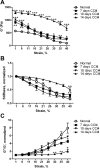
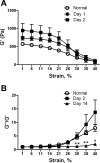


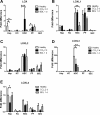
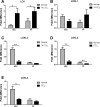
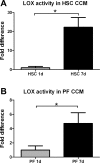


Similar articles
-
Periostin promotes liver fibrogenesis by activating lysyl oxidase in hepatic stellate cells.J Biol Chem. 2018 Aug 17;293(33):12781-12792. doi: 10.1074/jbc.RA117.001601. Epub 2018 Jun 25. J Biol Chem. 2018. PMID: 29941453 Free PMC article.
-
Lysyl oxidase activity contributes to collagen stabilization during liver fibrosis progression and limits spontaneous fibrosis reversal in mice.FASEB J. 2016 Apr;30(4):1599-609. doi: 10.1096/fj.14-268425. Epub 2015 Dec 23. FASEB J. 2016. PMID: 26700732
-
Extracellular matrix deposition, lysyl oxidase expression, and myofibroblastic differentiation during the initial stages of cholestatic fibrosis in the rat.Lab Invest. 1997 Jun;76(6):765-78. Lab Invest. 1997. PMID: 9194853
-
The characteristics of activated portal fibroblasts/myofibroblasts in liver fibrosis.Differentiation. 2016 Sep;92(3):84-92. doi: 10.1016/j.diff.2016.07.001. Epub 2016 Aug 31. Differentiation. 2016. PMID: 27591095 Free PMC article. Review.
-
Cooperation of liver cells in health and disease.Adv Anat Embryol Cell Biol. 2001;161:III-XIII, 1-151. doi: 10.1007/978-3-642-56553-3. Adv Anat Embryol Cell Biol. 2001. PMID: 11729749 Review.
Cited by
-
Emergence of highly profibrotic and proinflammatory Lrat+Fbln2+ HSC subpopulation in alcoholic hepatitis.Hepatology. 2023 Jul 1;78(1):212-224. doi: 10.1002/hep.32793. Epub 2022 Oct 25. Hepatology. 2023. PMID: 36181700 Free PMC article.
-
Molecular Mechanisms and Potential New Therapeutic Drugs for Liver Fibrosis.Front Pharmacol. 2022 Feb 11;13:787748. doi: 10.3389/fphar.2022.787748. eCollection 2022. Front Pharmacol. 2022. PMID: 35222022 Free PMC article. Review.
-
Carcinogenesis on the background of liver fibrosis: Implications for the management of hepatocellular cancer.World J Gastroenterol. 2018 Oct 21;24(39):4436-4447. doi: 10.3748/wjg.v24.i39.4436. World J Gastroenterol. 2018. PMID: 30357021 Free PMC article. Review.
-
Enhancer of Zeste Homologue 2 Inhibition Attenuates TGF-β Dependent Hepatic Stellate Cell Activation and Liver Fibrosis.Cell Mol Gastroenterol Hepatol. 2019;7(1):197-209. doi: 10.1016/j.jcmgh.2018.09.005. Epub 2018 Sep 15. Cell Mol Gastroenterol Hepatol. 2019. PMID: 30539787 Free PMC article.
-
Tissue mechanics coevolves with fibrillar matrisomes in healthy and fibrotic tissues.Matrix Biol. 2022 Aug;111:153-188. doi: 10.1016/j.matbio.2022.06.006. Epub 2022 Jun 25. Matrix Biol. 2022. PMID: 35764212 Free PMC article. Review.
References
-
- Barry-Hamilton V, Spangler R, Marshall D, McCauley S, Rodriguez HM, Oyasu M, Mikels A, Vaysberg M, Ghermazien H, Wai C, Garcia CA, Velayo AC, Jorgensen B, Biermann D, Tsai D, Green J, Zaffryar-Eilot S, Holzer A, Ogg S, Thai D, Neufeld G, Van Vlasselaer P, Smith V. Allosteric inhibition of lysyl oxidase-like-2 impedes the development of a pathologic microenvironment. Nat Med 16: 1009–1017, 2010 - PubMed
-
- Bourbonnais E, Raymond VA, Ethier C, Nguyen BN, El-Leil MS, Meloche S, Bilodeau M. Liver fibrosis protects mice from acute hepatocellular injury. Gastroenterology 142: 130–139, 2012 - PubMed
-
- Brenner DA, Waterboer T, Choi SK, Lindquist JN, Stefanovic B, Burchardt E, Yamauchi M, Gillan A, Rippe RA. New aspects of hepatic fibrosis. J Hepatol 32 Suppl: 32–38, 2000 - PubMed
Publication types
MeSH terms
Substances
Grants and funding
LinkOut - more resources
Full Text Sources
Other Literature Sources
Medical

